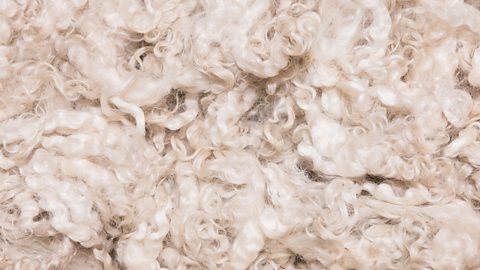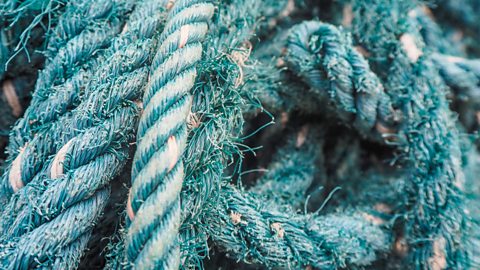Textiles - natural and synthetic fibres
Types of textiles and their uses
fibreSingle, hair-like strands that derive from either natural or synthetic sources. can be classified into two categories:
- natural polymers
- manufactured (or synthetic) polymers
Fibres are twisted into yarnShort threads spun to form one long thread., which are either woven or knitted into fabrics. These fabrics have their own characteristics, but often reflect the properties of the fibre.
Natural fibres
Natural fibres come from plants, animals or insects. They are easily renewableInexhaustible and replaceable. and biodegradableMaterial that can be broken down in the environment by microorganisms..
| Natural fibre | Properties | Uses |
| Cotton (plant) | Highly absorbent so is comfortable to wear, strong and durable, easy to care for but can shrink and has poor elasticity so creases | Most clothing, bed linen, upholstery fabric and in the medical industry (because it can be boiled) |
| Linen (plant) | Highly absorbent and cool to wear, very strong and durable, poor elasticity so creases easily | Summer clothing, upholstery fabric, table clothes and napkins |
| Hemp (plant) | Absorbent, strong and naturally antibacterial | Carpets, rugs and ropes |
| Jute (plant) | Absorbent and very strong but coarse | Bags, sacks for vegetables, carpets and twine |
| Wool (animal) | Absorbent with good insulating properties due to the fibreÔÇÖs natural crimp (curl), has good elasticity so doesnÔÇÖt crease much, relatively strong but can shrink on washing | Jumpers, suits, carpets and blankets |
| Silk (insect) | Drapes well and has good lustre (sheen), absorbent but difficult to wash and creases | Luxury clothing, eg dresses, underwear and bedding |
| Natural fibre | Cotton (plant) |
|---|---|
| Properties | Highly absorbent so is comfortable to wear, strong and durable, easy to care for but can shrink and has poor elasticity so creases |
| Uses | Most clothing, bed linen, upholstery fabric and in the medical industry (because it can be boiled) |
| Natural fibre | Linen (plant) |
|---|---|
| Properties | Highly absorbent and cool to wear, very strong and durable, poor elasticity so creases easily |
| Uses | Summer clothing, upholstery fabric, table clothes and napkins |
| Natural fibre | Hemp (plant) |
|---|---|
| Properties | Absorbent, strong and naturally antibacterial |
| Uses | Carpets, rugs and ropes |
| Natural fibre | Jute (plant) |
|---|---|
| Properties | Absorbent and very strong but coarse |
| Uses | Bags, sacks for vegetables, carpets and twine |
| Natural fibre | Wool (animal) |
|---|---|
| Properties | Absorbent with good insulating properties due to the fibreÔÇÖs natural crimp (curl), has good elasticity so doesnÔÇÖt crease much, relatively strong but can shrink on washing |
| Uses | Jumpers, suits, carpets and blankets |
| Natural fibre | Silk (insect) |
|---|---|
| Properties | Drapes well and has good lustre (sheen), absorbent but difficult to wash and creases |
| Uses | Luxury clothing, eg dresses, underwear and bedding |

Manufactured (or synthetic) fibres
Synthetic fibres are made mainly from non-renewableA resource that cannot be replaced when it is used up, such as oil, natural gas or coal. coal and oil refinedRemove unwanted substances from a substance. into monomers, which join together in a process called polymerisationThe process of joining of monomers to produce a polymer.. The do not degradeTo break down and deteriorate. easily but they can be made into any length (continuous filament) and thickness and for any purpose.
| Manufactured fibre | Properties | Uses |
| Acrylic | Like all synthetic fibres, has good strength with good elastic properties so doesnÔÇÖt crease, has poor absorbency but can be a good insulator if crimp is added to replicate wool fibres | Jumpers and other knitted clothing that looks like wool, fake fur jackets |
| Polyester | Hardwearing with good tensile strength, good elasticity but poor absorbency, a highly versatile fibre | Clothing and sportswear |
| Nylon (polyamide) | A hardwearing fibre with good tensile strength, has good elasticity so doesnÔÇÖt crease and is resistant to chemicals, not absorbent and melts easily | Parachutes, tents, rucksacks, sports clothing, rope and carpets |
| Elastane | Highly elastic and stretchy, strong and hardwearing | Clothing such as leotards, swimming costumes and gym clothing, mixed with cotton in T-shirts for a better fit |
| Manufactured fibre | Acrylic |
|---|---|
| Properties | Like all synthetic fibres, has good strength with good elastic properties so doesnÔÇÖt crease, has poor absorbency but can be a good insulator if crimp is added to replicate wool fibres |
| Uses | Jumpers and other knitted clothing that looks like wool, fake fur jackets |
| Manufactured fibre | Polyester |
|---|---|
| Properties | Hardwearing with good tensile strength, good elasticity but poor absorbency, a highly versatile fibre |
| Uses | Clothing and sportswear |
| Manufactured fibre | Nylon (polyamide) |
|---|---|
| Properties | A hardwearing fibre with good tensile strength, has good elasticity so doesnÔÇÖt crease and is resistant to chemicals, not absorbent and melts easily |
| Uses | Parachutes, tents, rucksacks, sports clothing, rope and carpets |
| Manufactured fibre | Elastane |
|---|---|
| Properties | Highly elastic and stretchy, strong and hardwearing |
| Uses | Clothing such as leotards, swimming costumes and gym clothing, mixed with cotton in T-shirts for a better fit |

Image caption, Nylon rope
Image caption, Nylon fabric
1 of 2
Blended
Blended fibres are mixtures of fibres that combine properties of two or more fibres.
| Blended fibre | Properties | End uses |
| Polycotton | A blend of cotton (60%) and polyester (40%) fibres to improve the properties of each, cotton has poor elasticity and creases but polyester has good elasticity so doesnÔÇÖt crease, cotton is absorbent so comfortable to wear but polyester isnÔÇÖt absorbent so doesnÔÇÖt let the skin breathe as well | Easy care shirts, bed linen and duvet covers |
| Blended fibre | Polycotton |
|---|---|
| Properties | A blend of cotton (60%) and polyester (40%) fibres to improve the properties of each, cotton has poor elasticity and creases but polyester has good elasticity so doesnÔÇÖt crease, cotton is absorbent so comfortable to wear but polyester isnÔÇÖt absorbent so doesnÔÇÖt let the skin breathe as well |
| End uses | Easy care shirts, bed linen and duvet covers |